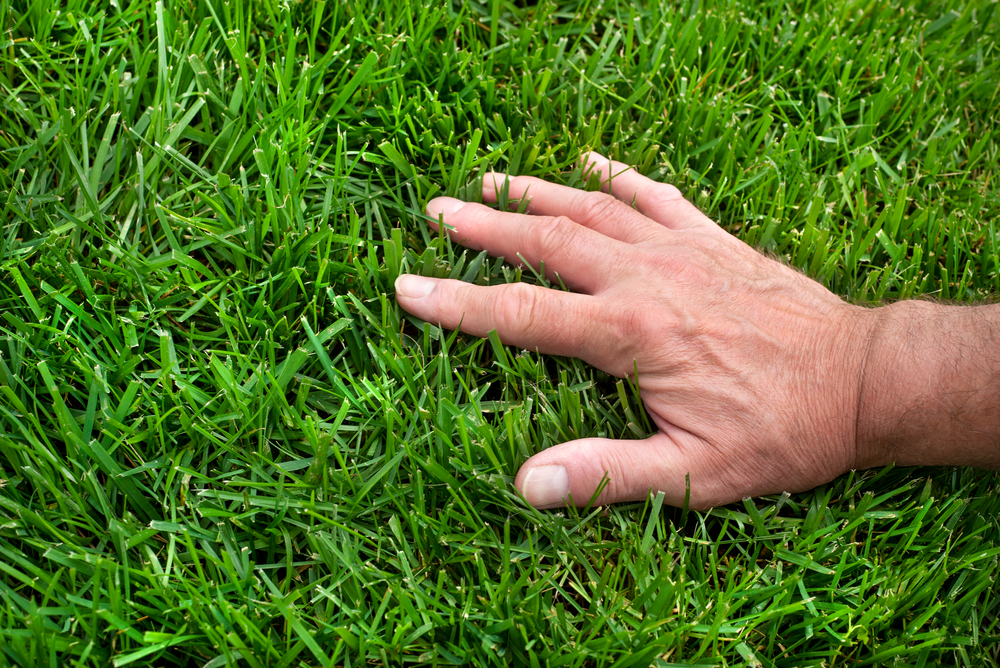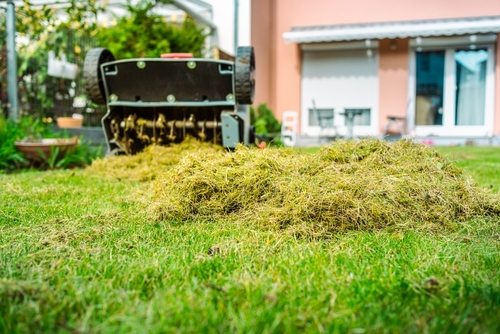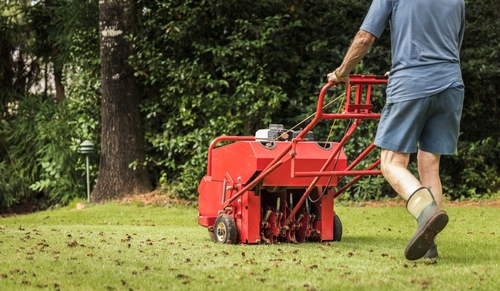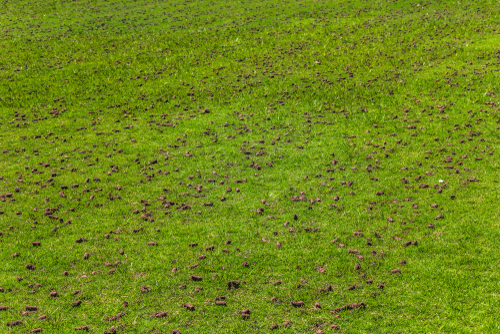
Everyone wants that thick, green lawn that makes the whole house look better, but it takes more than just mowing and watering to get there. One of the best-kept secrets to a healthy yard is core aeration, and in Decatur, IL, where clay-heavy soil and cool-season grasses dominate, it can be the difference between a thin, patchy lawn and one that really thrives.
In this guide, we’ll walk you through everything you need to know: what aeration actually does, how often you should do it, the most effective methods, mistakes to steer clear of, and how to care for your lawn afterward. By the end, you’ll have a clear, step-by-step plan to give your grass the breathing room it needs to grow thick, lush, and resilient.
What is lawn aeration and why does it matter?
Over time, the ground under your lawn gets packed down by walking, mowing, and just natural settling. In Decatur, where clay soil is the norm, this happens even faster, and it makes it tough for grass roots to breathe and grow the way they should. That’s why aerating your lawn has become so important. By pulling out small plugs of soil, you open up the ground and let air, water, and nutrients move freely again.

Here’s what that does for your lawn:
- Loosens hard soil so roots can spread deeper and stronger.
- Helps water and fertilizer soak in instead of running off.
- Breaks down thatch, the layer of dead grass that can smother new growth.
- Builds stronger roots, making your lawn more drought-resistant.
- Encourages thicker, healthier turf that holds up to heat and foot traffic.
How to tell if your lawn needs aeration
You don’t have to aerate your lawn every single year, but there are some clear signs that it might be time. Here’s what to look for:
- The screwdriver test: Try pushing a screwdriver or similar tool into the soil. If it won’t go in easily, your lawn is too compacted.
- Water pooling: After a rain, does water sit on the surface instead of soaking in? That’s a classic sign the soil is packed too tightly.
- Thin or bare patches: If grass is struggling to fill in even with proper watering and fertilizer, compacted soil may be holding roots back.
- Heavy traffic: Lawns that double as play areas, pet hangouts, or parking spots tend to compact faster and need aeration more often.
If more than one of these sounds familiar, your lawn will almost certainly benefit from aeration.
When is the best time to aerate grass lawn in Illinois?
Early fall is the best time to aerate lawns with cool-season grasses such as Kentucky bluegrass, fescue, and rye, which are common in Decatur. The soil remains warm, the grass is actively growing, and there’s enough time for recovery before winter sets in.
Spring is the second-best option, ideally in April or early May, when the soil is moist and grass is entering another strong growth period.
Avoid summer aeration. Heat-stressed grass won’t bounce back well, and compacted soil is harder to penetrate when it’s dry and baked in the sun. Also skip winter—frozen or waterlogged soil won’t aerate properly.
Think of fall aeration as a “reset button” for your lawn heading into the cooler months, with spring as a backup.
What is the most efficient way to aerate your lawn?
If you’re not sure how to do lawn aeration the right way, here’s the bottom line: efficiency isn’t just about results, it’s also about saving yourself time and effort. This is where a lot of homeowners get tripped up. There are a few different aeration methods out there, but only one really delivers lasting benefits: core aeration.
- Core aeration: Uses hollow tines to pull out small plugs of soil, usually 2–3 inches deep. This actually removes compacted soil and creates space for roots to grow stronger.
- Spike aeration: Solid spikes or those “aerator shoes” only push soil aside. In clay-heavy yards like we have in Decatur and the area, this can actually make compaction worse.
- Liquid aeration: Spray-on products that claim to loosen soil. They can be helpful as a supplement but won’t replace the benefits of pulling real soil plugs.
For the most efficient results, simply bring in a lawn care service. DIY hand tools work fine for tiny patches, but they aren’t practical for an entire yard. Professionals use commercial-grade machines that go deeper, work faster, and handle clay soil without a problem.
Preparing your lawn for aeration
A little prep work goes a long way in making aeration more effective. Here’s how to get your yard ready:
- Mow shorter than usual: Cut the grass down to about 1.5–2 inches. This helps the aerator reach the soil more easily.
- Water the day before: Aim for moist soil, soft enough for the machine to pull good plugs, but not soggy or muddy.
- Mark potentially hazardous areas: Flag sprinkler heads, shallow irrigation lines, or anything else you don’t want the aerator to damage.
- Plan your passes: If your soil is especially compacted, run the aerator twice in different directions to get better coverage.

Should I leave plugs after aerating my lawn?
Once you’ve finished aerating, your yard will be covered with little soil plugs. They can look messy at first, but resist the urge to rake them up, and leave them where they are. Within a week or two, rain and mowing will break those plugs down. As they decompose, they feed nutrients and beneficial microbes back into the soil, which helps reduce thatch and improve overall soil quality. Think of them as a free, natural topdressing for your lawn.
The only exception is if your grass is dealing with a disease that could spread. In that case, it may be safer to remove the plugs. Otherwise, let nature take care of them – they’ll disappear before you know it.
Can you aerate a lawn too much?
Yes, you can definitely overdo it. While aeration is great for relieving compaction, doing it too often can actually stress the grass and disrupt the soil. If you live in Decatur or the surrounding area, keep these things in mind:
- Once a year in the fall is usually all your lawn needs.
- Twice a year (fall and spring) can be helpful if you’ve got heavy clay soil or a yard that sees a lot of traffic from kids, pets, or vehicles.
- More than that is unnecessary and may do more harm than good.
What to do immediately after lawn aeration?
Lawn core aeration opens the door for nutrients and seed, so now’s the time to take advantage.
- Overseed: Spread grass seed to fill in bare patches and thicken the turf. The holes from aeration are perfect pockets for seed-to-soil contact.
- Fertilize: Apply a balanced fertilizer or starter fertilizer (if you overseeded). Nutrients reach the root zone more easily now.
- Water: Give the lawn a good soak within 48 hours. Keep soil consistently moist for the next two weeks to encourage seed germination and recovery.
- Minimize traffic: Stay off the lawn as much as possible for 10–14 days. This prevents compaction from returning and gives seedlings time to sprout.
- Delay mowing: Wait at least a week to mow, or longer if you overseeded. New grass should be 3–4 inches tall before its first cut.

Where can I find experts in core aeration near me in Decatur?
A lush, healthy lawn doesn’t happen by chance, it takes the right expertise and care, which is exactly what sets Classy Grass apart. With years of hands-on experience serving Decatur homeowners, we know exactly how the region’s clay-heavy soil and unpredictable weather affect your yard. Our team understands the challenges local lawns face in every season, which is why we provide tailored lawn care services designed to address your specific needs, core aeration and overseeding included.
If you’re looking for a team that knows how to read your yard, time the work for maximum results, you’re in the right place. Get in touch with us today!